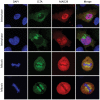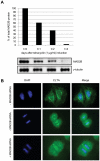The mitotic arrest deficient protein MAD2B interacts with the clathrin light chain A during mitosis
- PMID: 21152103
- PMCID: PMC2994903
- DOI: 10.1371/journal.pone.0015128
The mitotic arrest deficient protein MAD2B interacts with the clathrin light chain A during mitosis
Abstract
Background: Although the mitotic arrest deficient protein MAD2B (MAD2L2) is thought to inhibit the anaphase promoting complex (APC) by binding to CDC20 and/or CDH1 (FZR1), its exact role in cell cycle control still remains to be established.
Methodology/principal findings: Using a yeast two-hybrid interaction trap we identified the human clathrin light chain A (CLTA) as a novel MAD2B binding protein. A direct interaction was established in mammalian cells via GST pull-down and endogenous co-immunoprecipitation during the G2/M phase of the cell cycle. Through subsequent confocal laser scanning microscopy we found that MAD2B and CLTA co-localize at the mitotic spindle. Clathrin forms a trimeric structure, i.e., the clathrin triskelion, consisting of three heavy chains (CLTC), each with an associated light chain. This clathrin structure has previously been shown to be required for the function of the mitotic spindle through stabilization of kinetochore fibers. Upon siRNA-mediated MAD2B depletion, we found that CLTA was no longer concentrated at the mitotic spindle but, instead, diffusely distributed throughout the cell. In addition, we found a marked increase in the percentage of misaligned chromosomes.
Conclusions/significance: Previously, we identified MAD2B as an interactor of the renal cell carcinoma (RCC)-associated protein PRCC. In addition, we found that fusion of PRCC with the transcription factor TFE3 in t(X;1)(p11;q21)-positive RCCs results in an impairment of this interaction and a concomitant failure to shuttle MAD2B to the nucleus. Our current data show that MAD2B interacts with CLTA during the G2/M phase of the cell cycle and that depletion of MAD2B leads to a marked increase in the percentage of misaligned chromosomes and a redistribution of CLTA during mitosis.
Conflict of interest statement
Figures





Similar articles
-
The mitotic arrest deficient protein MAD2B interacts with the small GTPase RAN throughout the cell cycle.PLoS One. 2009 Sep 15;4(9):e7020. doi: 10.1371/journal.pone.0007020. PLoS One. 2009. PMID: 19753112 Free PMC article.
-
A novel binding protein of single-minded 2: the mitotic arrest-deficient protein MAD2B.Neurogenetics. 2012 Aug;13(3):251-60. doi: 10.1007/s10048-012-0333-x. Epub 2012 Jun 2. Neurogenetics. 2012. PMID: 22660985
-
Impairment of MAD2B-PRCC interaction in mitotic checkpoint defective t(X;1)-positive renal cell carcinomas.Proc Natl Acad Sci U S A. 2001 Nov 20;98(24):13808-13. doi: 10.1073/pnas.241304198. Proc Natl Acad Sci U S A. 2001. PMID: 11717438 Free PMC article.
-
The spindle checkpoint: how do cells delay anaphase onset?SEB Exp Biol Ser. 2008;59:243-56. SEB Exp Biol Ser. 2008. PMID: 18368927 Review.
-
The role of clathrin in mitotic spindle organisation.J Cell Sci. 2012 Jan 1;125(Pt 1):19-28. doi: 10.1242/jcs.094607. J Cell Sci. 2012. PMID: 22294613 Free PMC article. Review.
Cited by
-
Genome-wide association study revealed genomic regions related to white/red earlobe color trait in the Rhode Island Red chickens.BMC Genet. 2016 Aug 5;17(1):115. doi: 10.1186/s12863-016-0422-1. BMC Genet. 2016. PMID: 27496128 Free PMC article.
-
Dynamic feature of mitotic arrest deficient 2-like protein 2 (MAD2L2) and structural basis for its interaction with chromosome alignment-maintaining phosphoprotein (CAMP).J Biol Chem. 2017 Oct 27;292(43):17658-17667. doi: 10.1074/jbc.M117.804237. Epub 2017 Sep 8. J Biol Chem. 2017. PMID: 28887307 Free PMC article.
-
Genomic imbalances in patients with a clinical presentation in the spectrum of Cornelia de Lange syndrome.BMC Med Genet. 2013 Apr 3;14:41. doi: 10.1186/1471-2350-14-41. BMC Med Genet. 2013. PMID: 23551878 Free PMC article.
-
The multifaceted roles of the HORMA domain in cellular signaling.J Cell Biol. 2015 Nov 23;211(4):745-55. doi: 10.1083/jcb.201509076. J Cell Biol. 2015. PMID: 26598612 Free PMC article. Review.
-
REV7: a small but mighty regulator of genome maintenance and cancer development.Front Oncol. 2025 Jan 7;14:1516165. doi: 10.3389/fonc.2024.1516165. eCollection 2024. Front Oncol. 2025. PMID: 39839778 Free PMC article. Review.
References
-
- Cahill DP, da Costa LT, Carson-Walter EB, Kinzler KW, Vogelstein B, et al. Characterization of MAD2B and other mitotic spindle checkpoint genes. Genomics. 1999;58:181–187. - PubMed
-
- van den Hurk WH, Martens GJ, Geurts van Kessel A, van Groningen JJM. Isolation and characterization of the Xenopus laevis orthologs of the human papillary renal cell carcinoma-associated genes PRCC and MAD2L2 (MAD2B). Cytogenet Genome Res. 2004;106:68–73. - PubMed
Publication types
MeSH terms
Substances
LinkOut - more resources
Full Text Sources
Research Materials
Miscellaneous

